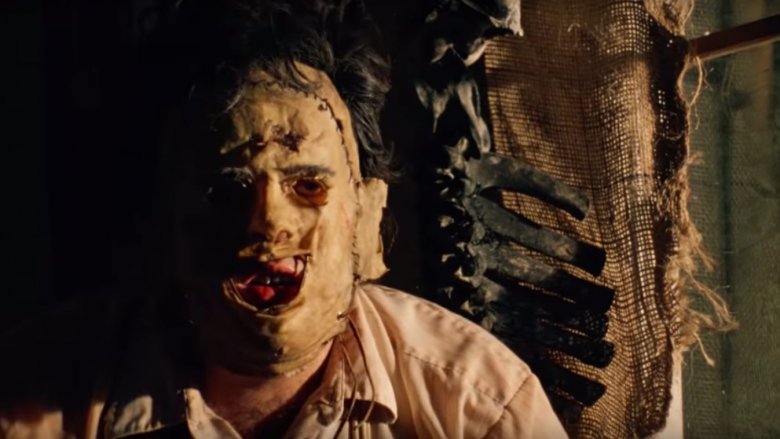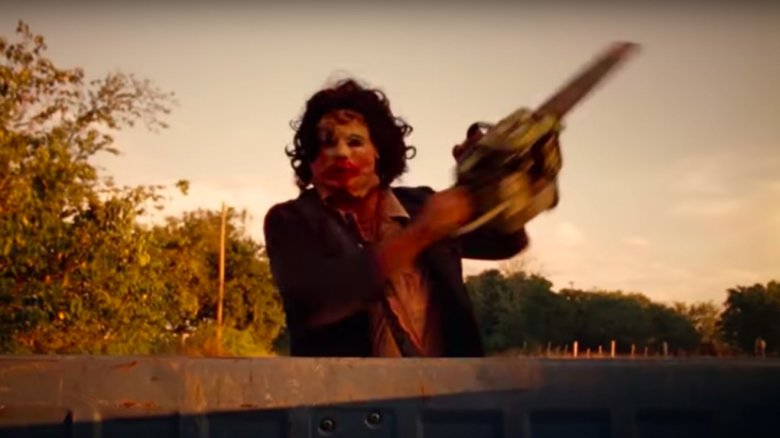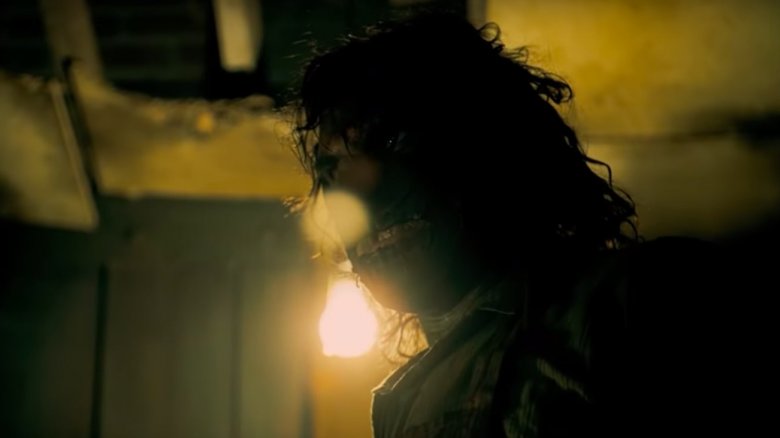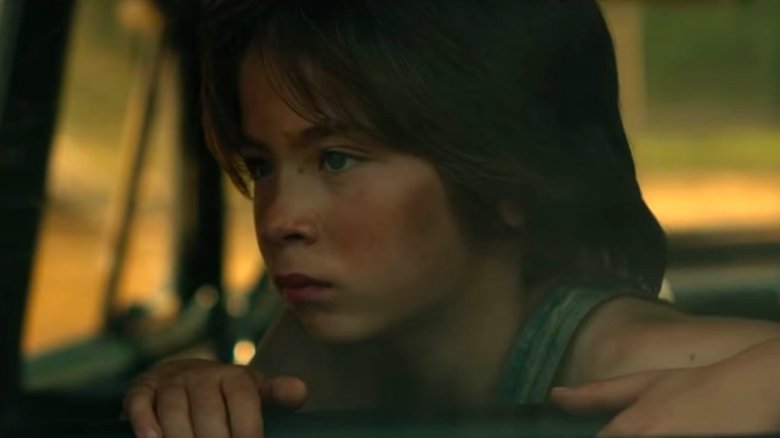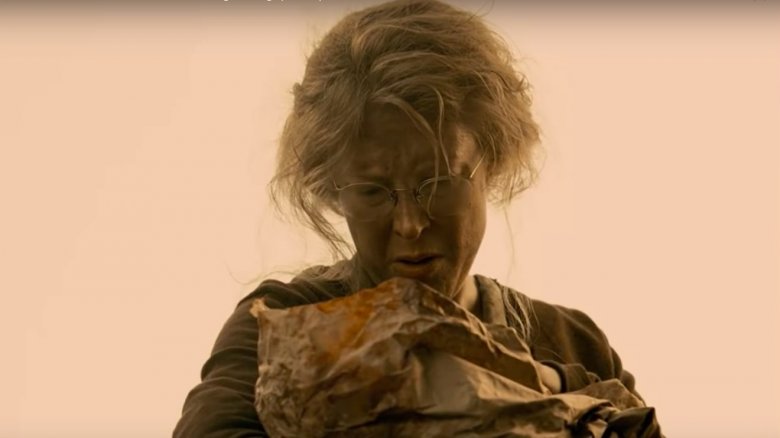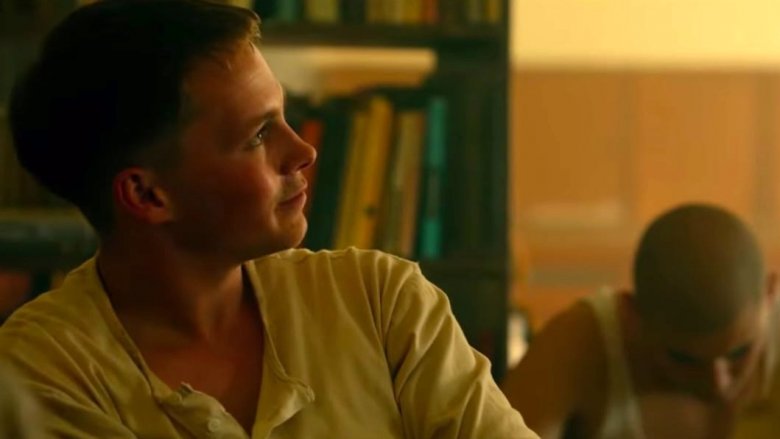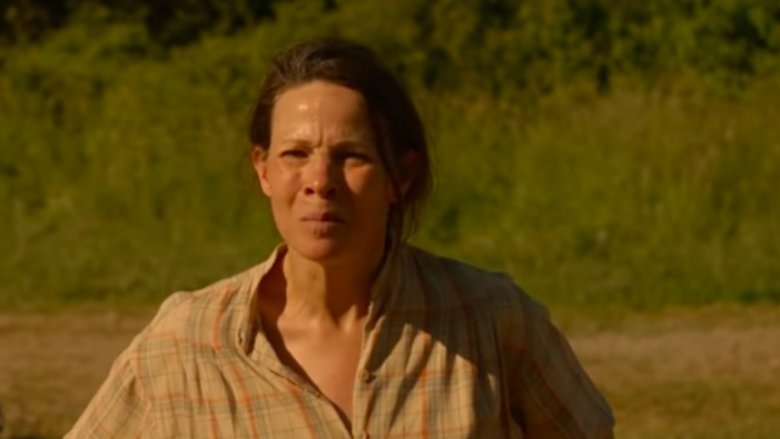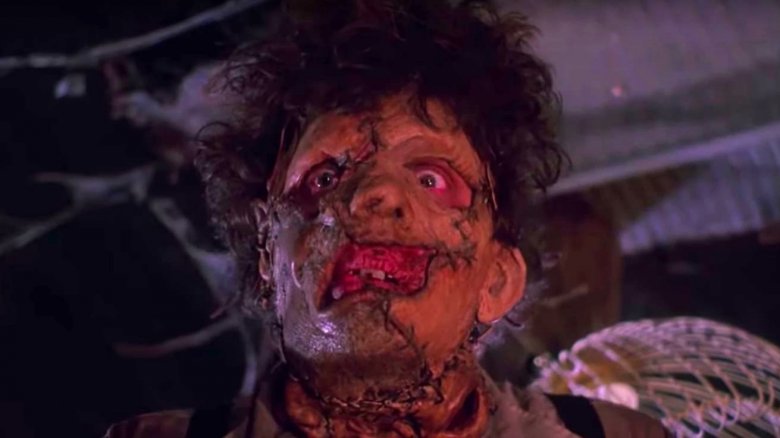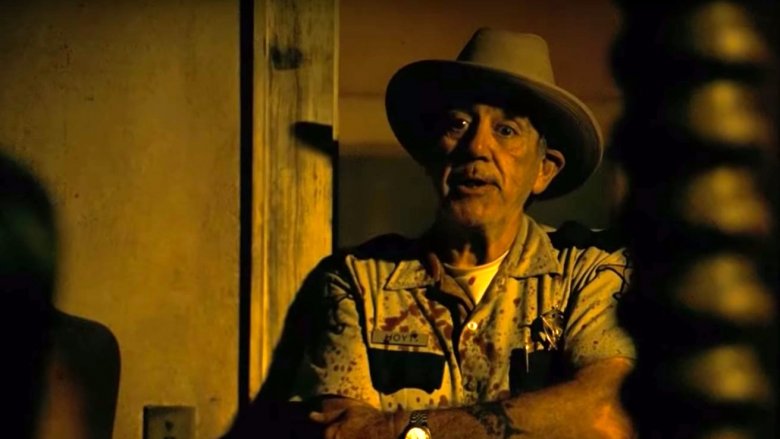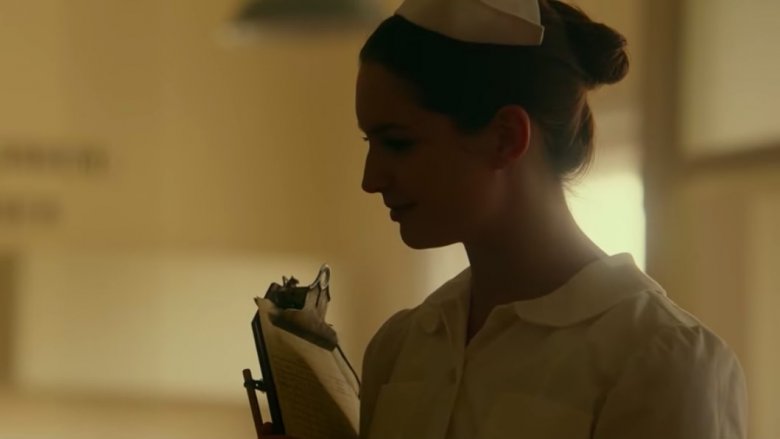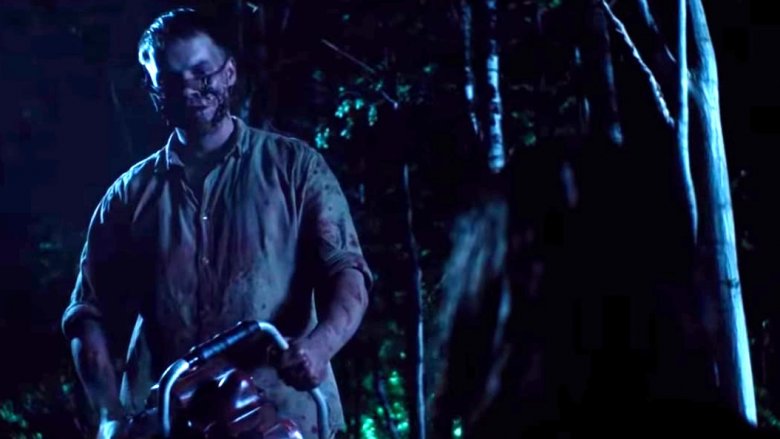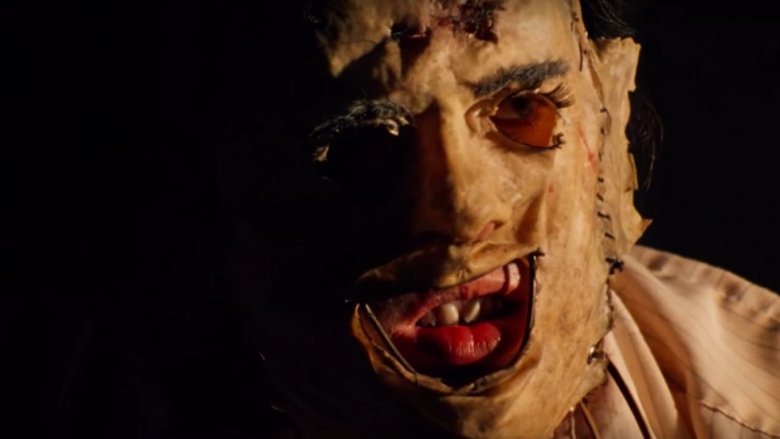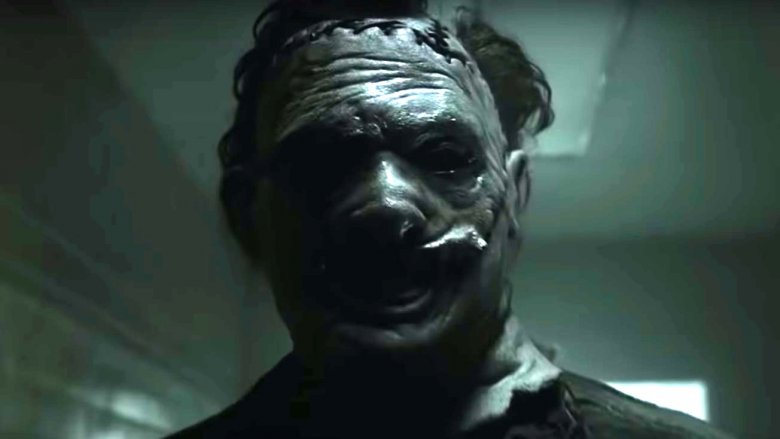Leatherface's Backstory Explained
With intriguing, suspenseful films like Get Out, Hereditary, and Midsommar earning rave reviews, it seems like horror is experiencing a modern revival, but the films that defined the genre decades ago are still worth watching — and few deliver on genuine scares from beginning to end like the 1974 slasher classic The Texas Chain Saw Massacre.
This terrifying film about a group of friends on an ill-fated road trip through rural Texas was shot on a tight budget with unknown actors, but it became one of the most influential movies in the entire genre. And it introduced an iconic villain into the world of horror: Leatherface. Leatherface hid behind a mask of human skin and killed his victims with hammers, meat hooks, and chainsaws. He wasn't the protagonist, but he was probably the most grotesquely fascinating figure in the film, and several subsequent movies within the franchise have explored his backstory. Here's how Leatherface became the monster behind that infamous mask.
Based on a true story
Leatherface looks like the kind of monster that director Tobe Hooper probably saw in a nightmare, but he wasn't a product of Hooper's imagination — he was actually based on a real person. The character of Leatherface was inspired by the murderer and graverobber Ed Gein, who was also known as "The Butcher of Plainfield." He lived in Plainfield, Wisconsin, and after the death of his controlling mother, who he was deeply devoted to, his mental health deteriorated.
Several residents of Plainfield went missing over the years, and Gein was found responsible for their deaths. He also admitted to robbing graves. An investigation of his home resulted in authorities finding organs stored in jars and masks made of human skin.
Hooper wasn't the only director who drew on the story of Gein for a horror film. Gein also served as the inspiration for films like Psycho and Silence of the Lambs. The events in The Texas Chainsaw Massacre were otherwise fictional (despite the introductory claim that you're about to watch a true story).
Born a victim
Why did Leatherface start wearing a mask to hide his face? Well, various films in The Texas Chain Saw Massacre franchise present different explanations.
Leatherface's official backstory isn't exactly cohesive. In the 40-plus years since the original film was released, different films in the franchise have explored slightly altered "origin stories." The 2003 remake and the 2006 prequel, The Texas Chain Saw Massacre: The Beginning, took place within one continous timeline and offered up an interesting explanation.
In this version, Leatherface was born disfigured, and he had a skin disease. Because of his strange appearance, he was relentlessly bullied and mocked. He wasn't very bright, but he was highly conscious of the fact that he was being treated so poorly. He was ashamed of the way he looked, so he began wearing a small leather mask to hide his face. This habit continued into adulthood, and eventually, the mask practically became a part of him.
A troubled background
Now, here's where the story starts to get a bit complicated. Not every film featuring a young Leatherface depicts him as disfigured or diseased. The 2017 film Leatherface, which specifically explores his childhood and teenage years, takes the story in another direction. The two narratives clearly deviate.
We're introduced to Leatherface as a young boy celebrating his birthday, and despite the creepy setting in the Sawyer household, he looks like an otherwise normal child. There's no sign of a skin disease, and nothing visibly wrong with him. In fact, there's really nothing distinct about his physical appearance that would set him apart from any other kid. He's certainly not having a normal childhood, but you wouldn't know it just by looking at him.
In this particular version of the story, Leatherface isn't hiding behind masks as a child. The explanation for how he obtains his very first mask is darker and more disturbing... but we'll get to that later.
Abandoned by his mother
In the 2006 prequel, Leatherface's life is traumatic from the moment he is born. His mother works at a slaughterhouse, and she dies giving birth to him at work. Her boss doesn't care about the infant's fate, so he leaves him behind in a dumpster, expecting him to die. A woman named Luda Mae Hewitt finds him and takes him in as her own son, naming him Thomas Hewitt.
Being adopted may have saved Thomas from dying in that dumpster — but the Hewitts weren't exactly a warm, loving family. Just like the Sawyer family in the original Texas Chain Saw Massacre, they're a violent group of cannibals, and Leatherface was doomed either way.
Although there is a lack of continuity in Leatherface's backstory between the films, one thing is always clear: the influence of his family, whether it was the Sawyers or the Hewitts, always prevented him from having a normal life. And in this prequel, being treated badly due to his appearance certainly didn't help.
Institutionalized as a child
So, we have a few stories about Leatherface's childhood — but how did he spend his teenage years? In the 2006 prequel, he began working at the slaughterhouse, where he worked until adulthood. But in Leatherface, that's not exactly how things played out.
After young lovers Betty Hartman and Ted Hardesty come across Jedidiah Sawyer on the side of the road, Betty worries about the child's safety and follows him back to a barn, hoping to help him. But the Sawyer family isn't kind to strangers on their property, and she quickly meets an untimely end. As it turns out, her dad is the local sheriff, and when he arrives at the Sawyer farm, he's shocked and saddened by the scene he discovers. Sheriff Hartman knows that no path of revenge will make up for the heartache he felt upon losing his daughter, but he needs to punish the Sawyers. As retribution, he sends Jedidiah away to a mental institution, despite the protests of his mom Verna. This is where the boy who will become Leatherface spends his teenage years.
Resisting his family's influence
In the 2006 prequel, we see how Leatherface is raised to be a murderer by the sadistic Hewitt family. But in Leatherface, he manages to resist his family's influence throughout his childhood. At his birthday party, his family announces his present — the chance to torture and kill a thief who tried to steal one of their pigs. But when they give him a chainsaw, Leatherface is visibly afraid. He doesn't want any part of the violent ritual. His relatives decide that Grandpa will kill the thief instead.
To truly become a part of the family, he needs to embrace their bloodlust — and throughout the film, his mother makes it clear that she'll make him "one of them" at any cost. She may be violent towards outsiders, but when it comes to her own family, she's fiercely protective. In this version of the story, it's clear that Leatherface knows what's expected of him, but deep down, he doesn't want to participate. So what makes him crack?
The breaking point
Whether the story starts with Leatherface as an innocent child amongst the twisted Sawyer clan, or the adopted Hewitt son who is relentlessly bullied, it always ends up going the same way for him: he reaches some breaking point, and becomes the monster we meet in the original Texas Chain Saw Massacre. Perhaps he wasn't born to be like the rest of his family, but he can never escape them.
In Leatherface, Jedidiah (who was renamed "Jackson" by the staff at the mental institution) leaves the institution after Verna breaks in to free him. After going on the run with a nurse and small group of inmates, he gets shot in the face, and his mother is the one who helps him stitch up his wounds. She knows that while he's vulnerable, she can sink her claws back into him and bring him back into the Sawyer family. When she finally puts a chainsaw back in his hands, he's ready to use it for the first time — on Sheriff Hartman, who had him institutionalized as a child.
Nature or nurture?
We know Leatherface's backstory deviates in certain places, depending on which films you're watching. In the 2006 prequel, it isn't Leatherface's mother who encourages him to give in to his worst impulses (although she certainly plays a role). In this case, Charlie Hewitt, Luda Mae's son, is the real culprit. When Leatherface loses his job at the slaughterhouse, he lets out his pent-up rage and kills his boss. When Sheriff Hoyt tries to arrest Leatherface, Hewitt steps in and kills him, then disguises himself as Hoyt. This allows them to escape.
After spending time with "Hoyt," the impressionable Thomas Hewitt completely becomes Leatherface — there's little humanity left. Once Hoyt takes control, it's all over. "I think there was a chance Thomas' life could have been different," said Terrence Evans, who played Old Monty in the film. "But the teasing he suffered, coupled with a bad temper, and following Hoyt around like a puppy dog, left room for Hoyt to get absolute control."
His first mask
Where did Leatherface actually get his first mask? In the 2006 prequel, he was initially wearing them simply to hide his skin disease — there was no sinister motive. But in Leatherface, his first mask was from one of his early victims: the nurse who left the mental institution with him and the other inmates.
Lizzy, new to the institution, and instantly takes a liking to "Jackson," who's charming and well-mannered compared to the rest of the patients. But their friendship is short-lived after Verna's break-in. After killing Hartman, Jedidiah chases after Lizzy with his chainsaw. She trips when her foot gets caught in a bear trap. Lizzy pleads with him for mercy and tries to appeal to his better nature, but when she insults his mother, all hope is lost for her. He swings his chainsaw and decapitates her, then stitches the skin from her face into his first mask, officially becoming Leatherface.
Laid off from the slaughterhouse
One detail is consistent in every Texas Chain Saw Massacre film: Leatherface's family has always been in the meat business. That explains why director Tobe Hooper actually went vegetarian while filming — thinking about what went on in slaughterhouses started to freak him out too much. In the 2006 prequel, Leatherface's killing spree begins when the health inspectors shut down the slaughterhouse where he works. And in the original Texas Chain Saw Massacre, all of the man in the Sawyer family worked at the local slaughterhouse. When they lost their jobs, they turned to murder and cannibalism.
When Sally Hardesty, the final survivor out of her group of friends in the 1974 film, is tortured and taunted during "dinner" with the Sawyers, they suggest that Grandpa should be the one kill her, because he was the best worker in the old slaughterhouse. Turns out he was no longer as strong and skilled — since he was too weak to finish the job, she escaped.
The meaning behind the masks
In Texas Chain Saw Massacre, Leatherface doesn't just wear one mask, he actually switches between a couple different ones, depending on the scene. Why does he change his mask? Is it just a random habit, or is there a deeper meaning? According to the late Gunnar Hansen, the actor who originally played Leatherface, the masks were not just creepy accessories. They were actually the only way Leatherface could really express himself.
"The reason [Leatherface] wore a mask, according to Tobe and Kim, was that the mask really determined his personality. Who he wanted to be that day determined what mask he put on," Hansen said. "So when Drayton comes home with Sally, Leatherface is wearing the 'Old Lady Mask' and he's wearing an apron and carrying a wooden spoon, he wants to be domestic, helpful in the kitchen. At dinner he wears a different face, the 'Pretty Woman,' which has makeup."
An unknown family
We know that Leatherface's family pushed him to become a murderer like the rest of the clan. We know that he eventually snapped and gave in. And we know that his masks are more than just masks. But after Leatherface became the monster we first laid eyes on in the original Texas Chain Saw Massacre, were there any other little-known details about his life incorporated into the films?
In Leatherface: The Texas Chainsaw Massacre III (1990), a new minor character in the Sawyer family is introduced — Leatherface's daughter. No, the identity of the mother is never revealed — that's simply left to the audience to speculate. But it's safe to say he's not winning any "Father of the Year" awards.
Leatherface is one of those classic movie villains who wasn't necessarily born evil — it was nurture rather than nature that made him who he was. But knowing his backstory doesn't make the original Texas Chain Saw Massacre any less frightening. If this film is in your Halloween movie lineup, you'll feel even more freaked out the next time you take a wrong turn in the middle of nowhere.
